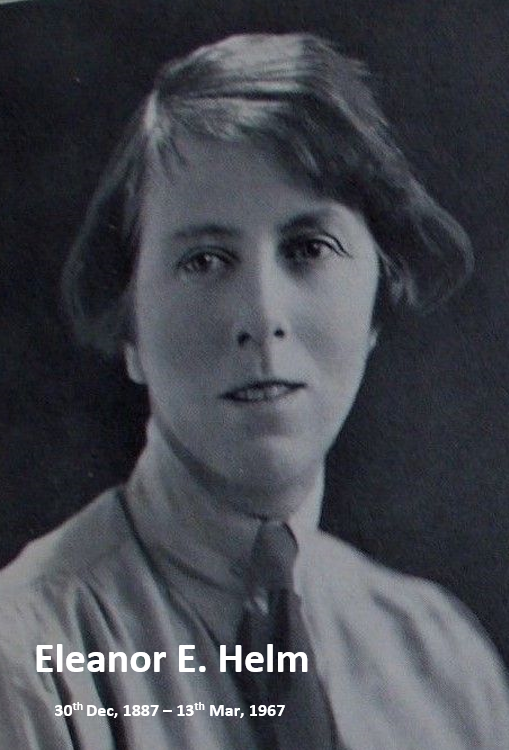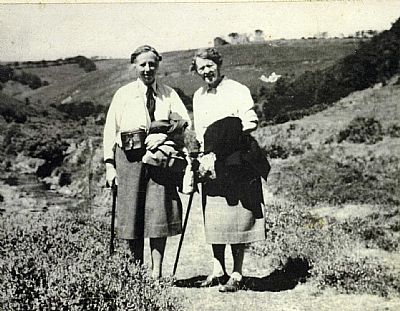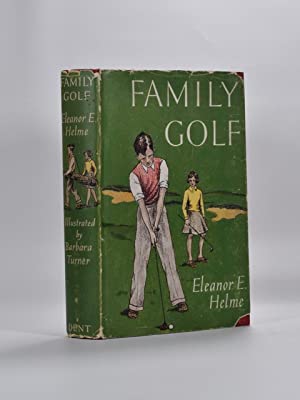
Born in Cobham, Surrey on 30th December, 1887, Eleanor Helme was the youngest of four children. Her father had been a merchant with the East India Company and a J.P. for Surrey. Her brother Thomas died in 1918 as a result of injuries sustained in the Great War. Her sisters were Vera and Emily.
Having spent some leisure time in the Exmoor area, Eleanor and Vera came to live in the village of Luccombe in West Somerset in 1947. They had a house called “Three Gates” built on the outskirts of the village by a local builder on land that they had purchased in 1933. This project fell foul of the strict post-war regulations which set an upper limit for the amount that could be spent on a new house.
GOLF & GOLFING BOOKS
In her younger days, Eleanor was an accomplished golfer, playing for her county from 1906 and being selected for the English Ladies team in 1911. Amongst her successes was the winning of a bronze medal in the 1924 Ladies Open Championship at Portrush, being beaten by the famous Joyce Wethered, (Lady Heathcoat-Amory).
She began a career as a golfing correspondent in 1910 with a special commission for the Yorkshire Post to report on the Territorial Tournament at Ganton, and was secretary to the Ladies Golf Union from 1912 to 1913. She took over the organization of the Eve ladies foursomes beginning with those held at Ranelagh in 1922, this competition being sponsored by the magazine of the same name, later to become Britannia and Eve. Further golfing achievements included: English International, 1911, 1912, 1913, 1920. Winner of the Ladies’ Field Foursomes with Miss Joy Winn at Harrogate and Ranelagh, 1921, Worplesdon Open Mixed Foursomes with Mr. T. A. Torrance, 1921, Barnehurst Scratch Challenge Bracelet, 1912, 1921, etc.
She became golf correspondent for “The Daily Telegraph” and “The Morning Post”, and by the 1930s she was the golfing editor for “The Bystander” magazine and “The Tatler”. In 1933 she was at the English Ladies Amateur Championship at Westward Ho! when she picked up a headline scoop on the occasion of Gloria Minoprio arriving at the first tee wearing trousers – an event that caused much consternation that there should be such a departure from the usual golfing costume worn at a championship!!
In addition to contributing countless golfing columns to several popular publications, Eleanor Helme wrote four golfing books which appeared in the inter-war years: “The Best of Golf’, published in 1923, “The Lady Golfers Tip Book” of 1925, “After the Ball” of 1931, and “Family Golf’ which appeared in 1938. A chapter on golf titled “The Making of a Golfer” was included in “Blackie’s Girls’ Annual” of 1930 and a chapter entitled “Why not Golf?” appeared in the “Girl’s Own Annual No.55”. She also contributed a chapter to “The Golfer’s Companion” of 1937.
Starting in 1926 Eleanor Helme made a number of radio broadcasts, initially for the British Broadcasting Company which then became the British Broadcasting Corporation in 1927. These included several talks on ladies golf and a total of nine summaries of ladies golf championship matches between 1927 and 1935. The “Encyclopaedia of Plymouth History” describes that the programmes of the Plymouth Rediffusion Service, (a radio forerunner of cable TV) were first listed in the “Western Evening Herald” of May 17th 1934 and that evening’s transmissions included an eye-witness account by Eleanor Helme of the Ladies Golf Championship at Porthcawl.

Some of her golf books included observations of various aspects of the flora and fauna that she had noticed while playing and reporting. This spawned a series of widlife books that were written in a style that would appeal to younger readers. They were lavishly illustrated with full- page colour plates and charming smaller line drawings by Barbara Briggs, F.Z.S. The publishers were the Religious Tract Society (also known as The “Great Thoughts Office” ), later to become the Lutterworth Press. Precise dating of these books is not easy as the publication dates were rarely included, however the WorldCat website has provided publication years for a number of these undated volumes.
GOLFING RECORD (Women Golfers’ Museum)
Clubs: Leatherhead, Burhill, Guildford, Stoke Poges, woodhall Spa, Moray, Effingham Manor.
Reached semi-final Ladies Championship 1924 and fifth round 1926. Partnered by Miss Joy Winnwon Ladies field Foursomes 1921 and Northern Foursomes 1921 and with T.A Torranc, Worplesdon open Foursomes 1921. Represented England 1911, 12 13 and 20. Women’s Golf Correspondent to “Morning Post”, “Bystander”, “Sporting and Dramatic” and author of “After the ball” (from Golfers Handbook 1934.
WILDLIFE BOOKS
Six books are in this group, “Friends of Field and Forest” (1926), “Feathered Friends of Field and Forest” (1928), Feathered Friends of Stream and Shore”(1929?), “Four-Footed Helpers” (1927), “Down The Stream” (1929) and “Five Thorn’s Farm” (1930). A seventh book, a large volume having the title “The Book of Birds and Beasties” (1929), is a compilation using extracts taken from the first four of the above works. The first editions of some of these titles, probably published in the 1920’s, are impressive, being 29 x 23 cm. having pictorial dust-wrappers, pictorial front covers, deckle-edged paper and ribbon bookmarks. The colour plates are tipped-in, individually mounted on separate boards. Later editions appeared around 1932, much smaller in size, and with the colour plates conventionally inserted. “Down the Stream” (1929), is believed to have been inspired by West Somerset’s Horner Water, following its course from the heights of Exmoor to the Bristol Channel.

A small selection of the books written by Eleanor Helme.
RELIGIOUS WORKS
Although there are known to be 15 “religious” titles naming Eleanor Helme as author, there were really only two books written. This is because the publishers, The Religious Tract Society, produced a number of smaller books made up of one or two chapters from one of the originals. All of these books were illustrated with coloured plates by Harold Copping.
The original book, first published in 1929, was called “The Perfect Friend, a Child’s Life of Christ”. This contained eight chapters, each being a story from the New Testament of the Bible. From this text, the “New Bible Picture Books” series emerged in the same year, being more simply bound, with card covers. The first four, each consisting of two chapters of the first book were called “The Footsteps of Jesus”, “In David’s Royal City”, “Jesus Lord & Master” and “Stories of Our Lord”. A further eight books were published, being even more cheaply bound, and containing just one chapter from the original. The titles of this series were: “Mary’s Babe”, “The Sea of Galilee”, “Jesus Our Friend”, “Jesus Our Healer”, “Stories of Jesus”, “The Friend of Children”, “Lord and Master” and “Jesus Our Saviour”. A number of these books in my collection contain bookplates that indicate that they were presented as Sunday school awards, and I believe that the R.T.S. published them cheaply, specifically for that purpose.
The original text also appeared as the second half of “The Greatest Gift” (1930), in which the first section, dealing with the Old Testament, was written by Maurice Kerr. A further work, “Animals of The Bible” (pub. 1927), illustrated by Barbara Briggs, may also be considered as coming under her “religious” category.
JERRY, THE JOKER AND OTHERS.
Eleanor’s most well-known book,”Jerry,The Story of an Exmoor Pony”*, was first published in 1930 by Eyre & Spottiswoode, and was set on the edge of Exmoor, at Cloutsham Farm. This was followed in 1932 by its sequel, “The Joker & Jerry Again”*. In 1933 the setting and theme moved to the Highlands of Scotland and treasure-hunting for “Seek There”*. “Mayfly, The Grey Pony” first appeared in 1935, with its sequel “Runaway Mike” coming out in 1936. A change of location to rural Surrey was used for “Roddy & Scuttle”* (c. 1937) , returning to Exmoor for the remainder of her books: “Shanks’s Pony” (1946), “Suitable Owners” (1948), “White Winter” (1949) and her last published book “Dear Busybody” (1950), which was set in Luccombe in the 1890’s. Another book was written as a sequel to “Dear Busybody”, but was never published. All of these books were illustrated with drawings by well-respected artists including Cecil Aldin and Lionel Edwards.
* indicates that book was co-written with Nance Paul.
- Thank you to: http://www.spanglefish.com/
THE LATER YEARS
Eleanor continued to live in Luccombe with Vera throughout the 1950’s and well in to the 1960’s, writing a regular column called “Country Corner” for the local newspaper, the “West Somerset Free Press”. She had her own pony called “Sarah” and used to ride regularly.
Eventually, age and ill-health forced a move to Minehead, where both sisters passed away in a nursing home within a few hours of each other on 13th March 1967. Eleanor was 80, Vera 85. Their funerals took place at Luccombe Church on 20th March 1967.
ARTICLE FROM BADGER BOOKS
Eleanor Helme was a witty and vivid writer, and an early contributor to the development of the pony book. She started her writing career as a golfing correspondent in 1910 for the Yorkshire Post: she was an excellent golfer herself and played for England in 1911, 1912, 1913 and 1920. Reporting on golf gave her time to indulge her other interests. She said:
‘… I enlivened a dull day’s reporting by watching, and describing, a butcher bird in a thorn bush. He was much more engaging than watching the golf. One of the weaker counties was holding a meeting; nobody could hit the ball more than 160 yards; if there was a bunker they made straight for it, when they arrived at the hole they carefully avoided it. The course was of the depressing kind which goes up and down (generally up) a field which, not so very long ago, was undoubtedly being plodded over by patient plough-horses. For a time I plodded with equal patience. Then I caught sight of my feathered friend. The lure was too strong.’

Eleanor Helme wrote four books on golf (all of them hard to find), and seven children’s books (one a compilation) on wildlife. If you can find them, these are beautifully illustrated and very attractive books, published by the Religious Tract Society, who also published her titles on Jesus. Again, these are rare. Much easier to find are her pony and farming stories. The majority of these are based on Exmoor, which she loved, and where she often holidayed. She and her sister, Vera, moved to Luccombe, on Exmoor, permanently after World War II, and here she built a house, ‘Three Gates.’
Her books have a very vivid sense of place. White Winter is a wonderful evocation of the sheer hard slog of living through the long and vicious winter of 1947 on Exmoor, and should be more widely read. It is part of the only series she wrote, about an Exmoor pony called Adam. All the titles are well worth finding. She wrote (with Nance Paul) a pair of books about an Exmoor pony, Jerry, which have considerable charm. One of my own favourites is Furlong Farm. The pony element is minimal, but it is a wonderful story of farming life.
Eleanor Helme was blessed with her illustrators: Lionel Edwards illustrated the Adam series, and Cecil Aldin Jerry. Her books are very attractive in their own right, and if you like the Country Life style of pony book, you will like these.
Bibliography (pony books only)
Jerry, the Story of an Exmoor Pony (with Nance Paul), 1930
The Joker and Jerry Again (with Nance Paul), 1932
Mayfly the Grey Pony, 1935
Runaway Mike, 1936
Shank’s Pony, 1946
Suitable Owners, 1948
White Winter, 1949
Dear Busybody, 1950
Golf books
The Best of Golf, 1923
The Ladies Golfer’s Tip Book, 1925; After the ball, 1931
Family Golf, 1938
Finding the books
All the books are fairly easy to find, and generally reasonably priced. The early editions of Jerry and The Joker and Jerry Again can be hard to find in their earlier printing styles. The one really tricky book to find is Mayfly with its dustjacket. Without its dj, it’s very common.
Sources
Eric Rowlands: Eleanor Helme: Columnist, Golfer, Author, Reporter, Naturalist and Lover of Exmoor (Horner Mill Services, 2002)
Correspondence with Eric Rowlands
Many thanks to Amanda Dolby, Dawn Harrison. Jacquie Aucott and Alison MacCallum for their help with the pictures.

Recent Comments